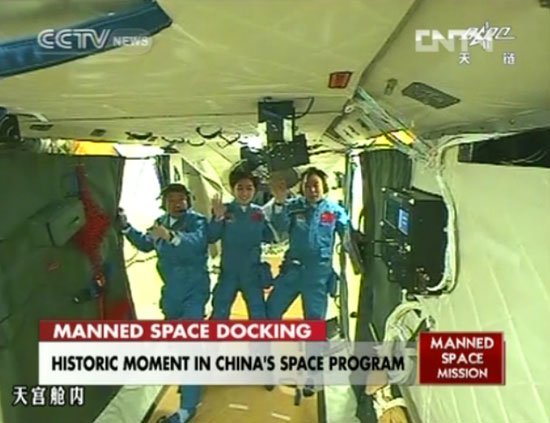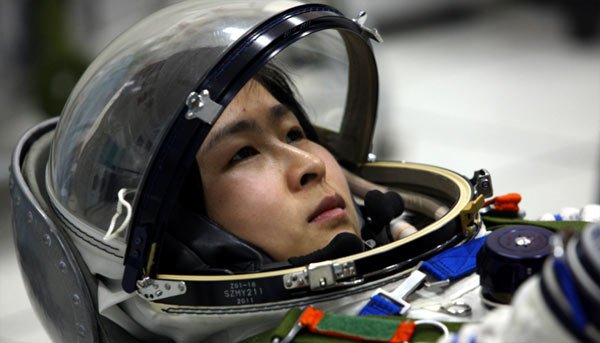China has successfully completed its first ever manual docking of a spacecraft with another space module as astronauts on the Shenzhou-9 spacecraft docked with the Tiangong-1 lab module without relying on an automated system.
State television broadcast images of Jing Haipeng, Liu Wang and China’s first female astronaut, Liu Yang, smiling after completing the exercise.
The docking is seen as a key step in the building of a space station, which China hopes to finish by 2020.
A manual docking procedure would be used in the event of a failure with the automated system.

Astronauts on the Shenzhou-9 spacecraft docked with the Tiangong-1 lab module without relying on an automated system
It is regarded as a difficult manoeuvre, bringing gently together two orbiting vessels travelling at thousands of miles an hour.
Liu Wang had been expected to take charge of the operation, while Liu Yang was to conduct aerospace experiments, according to Agence France-Presse news agency.
Manual docking was mastered by the USSR and US in the 1960s.
The Shenzhou-9 spacecraft was launched on 16 June.
It carried out a successful automatic docking when it reached the Tiangong-1 module on 18 June.
Every move of the mission has been watched with patriotic pride by China’s state media.
Even the astronauts’ first space meal – rice, pickled pork, barbecue sauce and tea – was reported, our correspondent says.
[youtube d761jSOtQLg]
Shenzhou-9 capsule, with its crew of three, including the first Chinese woman astronaut, has docked with the Tiangong-1 space lab.
The coupling of the vehicles occurred just after 14:00 Beijing time (06:00 GMT) over China itself.
The latest Shenzhou mission was launched on Saturday, taking the nation’s first female astronaut, Liu Yang, into orbit.
Thirty-three-year old Liu Yang flies with Commander Jing Haipeng, 46, and fellow flight engineer, Liu Wang, 42.
It is China’s fourth manned mission and another opportunity to see how far the Asian nation has developed its space technology.
It follows on from last year’s unmanned Shenzhou-8 outing which completed successful rendezvous and docking manoeuvres at Tiangong.

Shenzhou-9 capsule, with its crew of three, including the first Chinese woman astronaut, has docked with the Tiangong-1 space lab
That gave Beijing authorities the confidence to put astronauts on the current flight.
After Saturday’s lift-off from the Jiuquan spaceport, Shenzhou-9 worked through a series of engine burns to take it higher and closer to the orbiting space lab.
Monday’s docking was an automated procedure; computers – not the crew – were in charge of events.
A suite of radar, laser and optical sensors aligned Shenzhou with Tiangong. The capsule’s thrusters then drove it into the space lab’s docking ring.
The union happened at an altitude of about 340 km (210 miles). Liu Yang operated a handheld video camera to record the moment of docking.

Thirty-three-year old Liu Yang flies with Commander Jing Haipeng, 46, and fellow flight engineer, Liu Wang, 42
It is understood that only two members of the crew will enter the lab at any one time. The third individual will stay in the Shenzhou craft in case of emergency.
During the flight, a range of scientific experiments are planned, including a number of medical tests geared towards understanding the effects of weightlessness on the human body.
At some point in the next few days, the astronauts will attempt a manual docking.
This would see the crew uncouple their vehicle from the lab, retreat to a defined distance and then command their ship to re-attach itself.
Liu Wang will take the lead in this activity.
“We’ve done over 1,500 simulations,” he said during the pre-launch press conference.
“We’ve mastered the techniques and skills. China has first class technologies and astronauts, and therefore I’m confident we will fulfill the manual rendezvous.”
China is already talking about a Shenzhou-10 mission to Tiangong sometime in the next year.
The lab is a prototype for the type of modules the nation hopes to join in orbit later this decade to form a permanently manned space station.
At about 60 tons in mass, this proposed station would be considerably smaller than the 400-tonne international platform operated by the US, Russia, Europe, Canada and Japan, but its mere presence in the sky would nonetheless represent a remarkable achievement.
Concept drawings describe a core module weighing some 20-22 tons, flanked by two slightly smaller laboratory vessels.
Officials say it would be supplied by freighters in exactly the same way that robotic cargo ships keep the International Space Station (ISS) today stocked with fuel, food, water, air, and spare parts.
The Shenzhou-9 crew is expected back on Earth before the end of the month.
China is about to launch its fourth manned space mission and is sending a crew of three, including the nation’s first female astronaut, to the orbiting Tiangong space lab.
Chinese Shenzhou-9 capsule is set to lift off from the Jiuquan spaceport on the edge of the Gobi desert at 18:37 local time (10:37 GMT).
A Long March 2F rocket will put the astronauts on a path to dock with Tiangong in a couple of days’ time.
They will then spend over a week living and working in orbit before returning to Earth.
The mission is commanded by Jing Haipeng, who is making his second spaceflight after participating in the Shenzhou-7 outing in 2008 – the mission that included China’s first spacewalk.
Jing Haipeng’s flight engineers are both first-timers.
Liu Wang, a People’s Liberation Army fighter pilot, has got his chance after spending 14 years in the China National Space Administration’s astronaut corps.
Liu Yang, on the other hand, has emerged as China’s first woman spacefarer after just two years of training.
Her role in the mission will be to run the medical experiments in orbit.

Liu Yang has emerged as China's first woman spacefarer after just two years of training
Shenzhou-9 follows on from the unmanned Shenzhou-8 venture last year that tested the technologies required to join a capsule to the Tiangong lab.
Those manoeuvres went very well and gave Chinese officials the confidence to send up humans.
When it arrives at Tiangong, the Shenzhou-9 craft is expected to make a fully automated docking, but there is a plan to try a manual docking later in the mission.
This would see the crew uncouple their vehicle from the lab, retreat to a defined distance and then command their ship to re-attach itself.
Liu Wang will take the lead in this activity.
“We’ve done many simulations,” he said during the pre-launch press conference.
“We’ve mastered the techniques and skills. China has first class technologies and astronauts, and therefore I’m confident we will fulfill the manual rendezvous.”
Tiangong is the next step in a strategy that Beijing authorities hope will lead ultimately to the construction and operation of a large, permanently manned space station.
It is merely the prototype for the modules China expects to build and join in orbit. Mastering the rendezvous and docking procedures is central to this strategy.
At about 60 tons in mass, this proposed station would be considerably smaller than the 400-tonne international platform operated by the US, Russia, Europe, Canada and Japan, but its mere presence in the sky would nonetheless represent a remarkable achievement.
Concept drawings describe a core module weighing some 20-22 tons, flanked by two slightly smaller laboratory vessels.
Officials say it would be supplied by freighters in exactly the same way that robotic cargo ships keep the International Space Station (ISS) today stocked with fuel, food, water, air, and spare parts.
China is investing billions of dollars in its space programme. It has a strong space science effort under way, with two orbiting satellites having already been launched to the Moon. A third mission is expected to put a rover on the lunar surface.
The Asian country is also deploying its own satellite-navigation system known as BeiDou, or Compass.
Before leaving Earth, Liu Yang said the Shenzhou-9 mission would generate further pride in Chinese people.
“When I was a pilot I flew in the sky; now as an astronaut, I’m going into space. It’s higher and it’s farther,” she said.
“I have a lot of tasks to fulfill, but besides these tasks I want to feel the unique environment in space and admire the views. I want to explore a beautiful Earth, a beautiful home.
“I want to record all my feelings and my work, to share with my friends, and my comrades and my future colleagues.”
[youtube abW_ebGbFKM]




